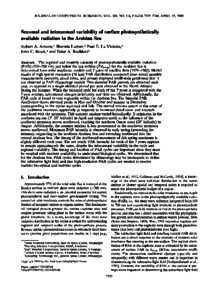Document
Seasonal and interannual variability of surface photosynthetically available radiation in the Arabian Sea.
Identifier
DOI: 10.1029/97jc03204
Source
Journal of Geophysical Research: Oceans. v. 103, 3334, p. 7735-7748
Contributors
Ladner, Sherwin., Author
La Violette, Paul E., Author
Brock, John C., Author
Rochford, Peter A., Author
Country
United Kingdom.
City
Oxford.
Publisher
Blackwell Publishing Ltd.
Gregorian
1998-04-15
Language
English
English abstract
The regional and monthly intensity of photosynthetically available radiation (PAR) (350-700 nm) just below the sea surface (EdPAR-) for the Arabian Sea is determined from solar irradiance models and 7 years of satellite data (1979-1985). Model results of high spatial resolution (18 km) PAR distribution computed from actual monthly measurements (aerosols, cloud cover, and ozone) displayed small-scale patchiness that is not observed in PAR climatology models. Two elevated PAR periods are observed each year, as opposed to a single elevated period per year observed in the North Atlantic during the summer. When the biannual cycle for each of the 7 years is compared with the 7-year average, interannual changes in intensity and time are observed. Additionally, the PAR cycle is found to vary regionally within the Arabian Sea. The bimodal PAR distribution shows elevated peaks in May and October and minima in December (corresponding to the winter equinox) and July. The second minima occurs at the onset of the southwest monsoon, apparently in response to increased cloud cover and aerosols associated with the monsoon. This summer minima varied latitudinally. It originates in the southern regions (0°-10° latitude) in April and migrates north as the influence of the southwest monsoon moves northward, reaching the northern Oman coast (20° latitude) in August. Additionally, the summer minima is less pronounced as the southwest monsoon moves northward. Maximum PAR intensity is observed in early spring (preceding the minima), originating in the southern Arabian Sea and extending northward into the central Arabian Sea. The timing of the northward movement of this spring maximum is slightly different each year. The net yearly PAR intensity for each of the 7 years appears to remain approximately the same, despite the interannual variability in the cycle and regional variability. The timing and location of PAR cycles are important since they must be coupled with nutrient availability to understand biological cycles. We determined that for the Arabian Sea,' PAR cycles determined by climatology may be inadequate to define the submarine light field and that high-resolution PAR cycles are needed to resolve realistic bio-optical and nutrient cycles.
ISSN
2169-9291
Category
Journal articles

